Taxation Law Assignment: LAWS20060 Individual Assignment Term 1
VerifiedAdded on 2022/12/26
|12
|3434
|76
Homework Assignment
AI Summary
This document provides a comprehensive solution to a Taxation Law assignment, addressing key concepts of Australian taxation. The assignment covers various aspects of the Income Tax Assessment Act 1997, including the computation of depreciating assets, tax offsets, and tax rates. It delves into Capital Gains Tax (CGT) events, exemptions, and calculations. The solution analyzes different scenarios related to tax deductions, distinguishing between business and personal expenses, and examining the implications of various expenditures. Furthermore, it differentiates between average and marginal tax rates, and explains consumption tax. The assignment also explores CGT events like lease grants and options, and examines the tax treatment of prize money and employee reimbursements. Finally, the document includes a detailed computation of capital gains and losses for different investment scenarios.
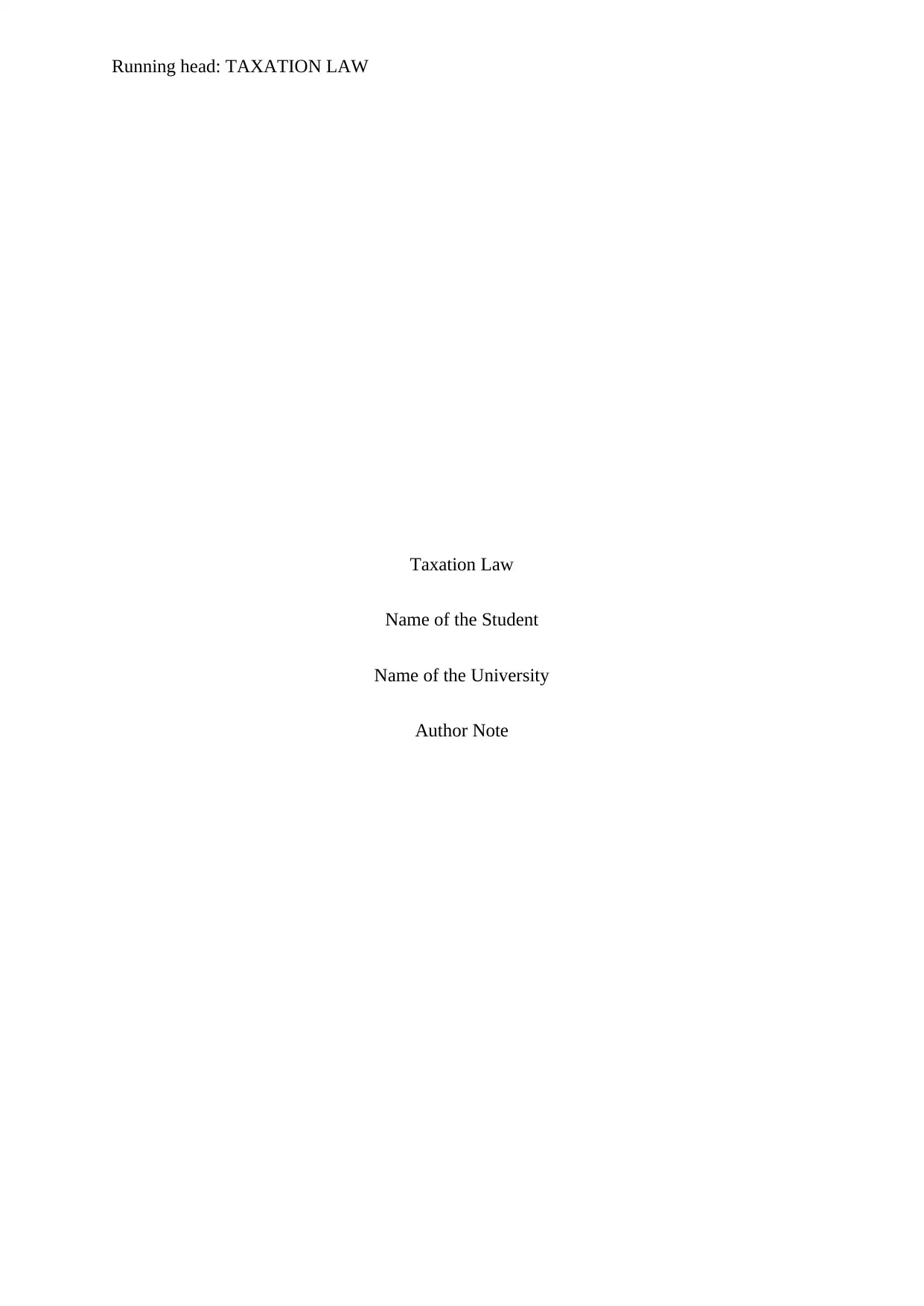
Running head: TAXATION LAW
Taxation Law
Name of the Student
Name of the University
Author Note
Taxation Law
Name of the Student
Name of the University
Author Note
Paraphrase This Document
Need a fresh take? Get an instant paraphrase of this document with our AI Paraphraser
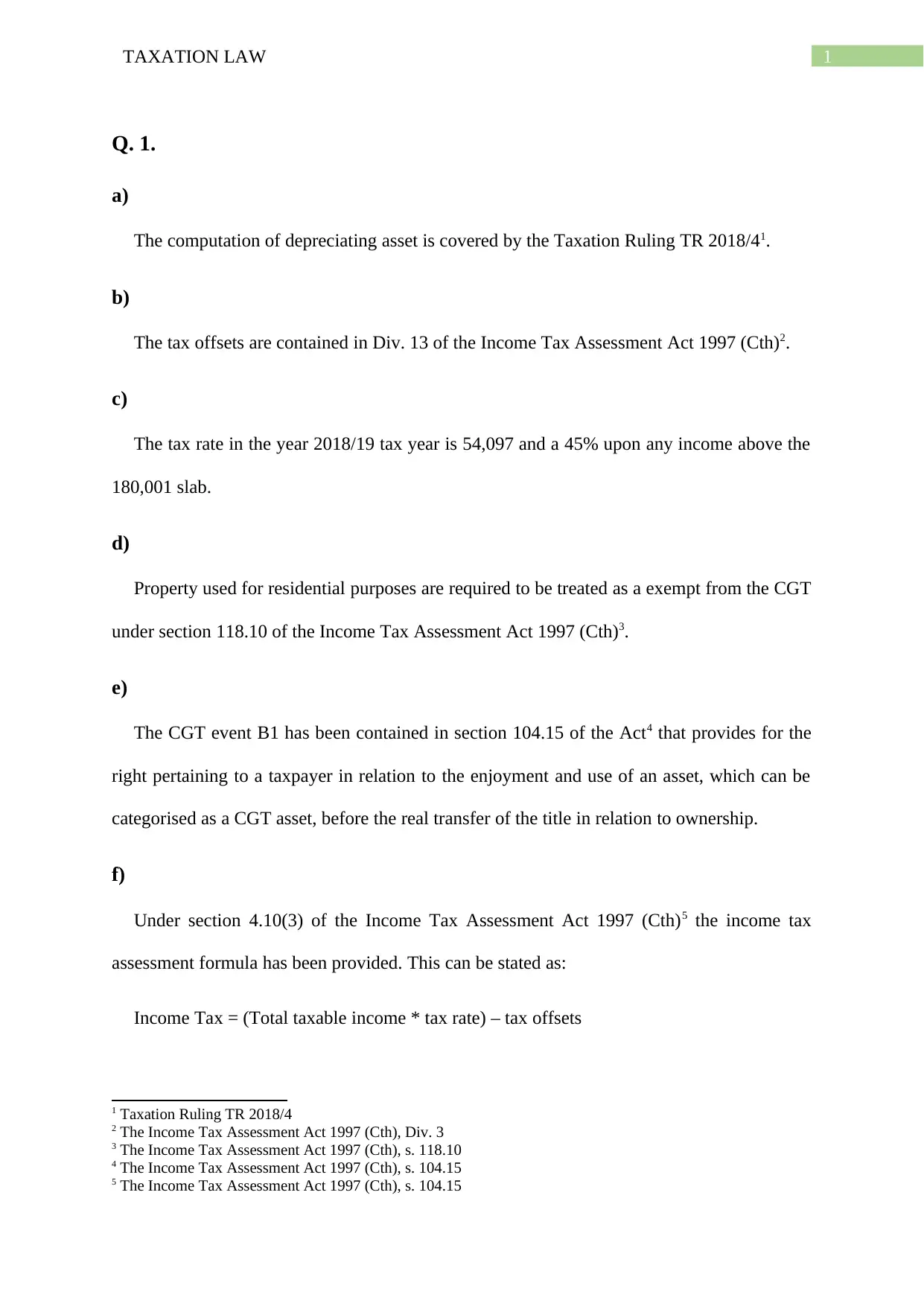
1TAXATION LAW
Q. 1.
a)
The computation of depreciating asset is covered by the Taxation Ruling TR 2018/41.
b)
The tax offsets are contained in Div. 13 of the Income Tax Assessment Act 1997 (Cth)2.
c)
The tax rate in the year 2018/19 tax year is 54,097 and a 45% upon any income above the
180,001 slab.
d)
Property used for residential purposes are required to be treated as a exempt from the CGT
under section 118.10 of the Income Tax Assessment Act 1997 (Cth)3.
e)
The CGT event B1 has been contained in section 104.15 of the Act4 that provides for the
right pertaining to a taxpayer in relation to the enjoyment and use of an asset, which can be
categorised as a CGT asset, before the real transfer of the title in relation to ownership.
f)
Under section 4.10(3) of the Income Tax Assessment Act 1997 (Cth)5 the income tax
assessment formula has been provided. This can be stated as:
Income Tax = (Total taxable income * tax rate) – tax offsets
1 Taxation Ruling TR 2018/4
2 The Income Tax Assessment Act 1997 (Cth), Div. 3
3 The Income Tax Assessment Act 1997 (Cth), s. 118.10
4 The Income Tax Assessment Act 1997 (Cth), s. 104.15
5 The Income Tax Assessment Act 1997 (Cth), s. 104.15
Q. 1.
a)
The computation of depreciating asset is covered by the Taxation Ruling TR 2018/41.
b)
The tax offsets are contained in Div. 13 of the Income Tax Assessment Act 1997 (Cth)2.
c)
The tax rate in the year 2018/19 tax year is 54,097 and a 45% upon any income above the
180,001 slab.
d)
Property used for residential purposes are required to be treated as a exempt from the CGT
under section 118.10 of the Income Tax Assessment Act 1997 (Cth)3.
e)
The CGT event B1 has been contained in section 104.15 of the Act4 that provides for the
right pertaining to a taxpayer in relation to the enjoyment and use of an asset, which can be
categorised as a CGT asset, before the real transfer of the title in relation to ownership.
f)
Under section 4.10(3) of the Income Tax Assessment Act 1997 (Cth)5 the income tax
assessment formula has been provided. This can be stated as:
Income Tax = (Total taxable income * tax rate) – tax offsets
1 Taxation Ruling TR 2018/4
2 The Income Tax Assessment Act 1997 (Cth), Div. 3
3 The Income Tax Assessment Act 1997 (Cth), s. 118.10
4 The Income Tax Assessment Act 1997 (Cth), s. 104.15
5 The Income Tax Assessment Act 1997 (Cth), s. 104.15
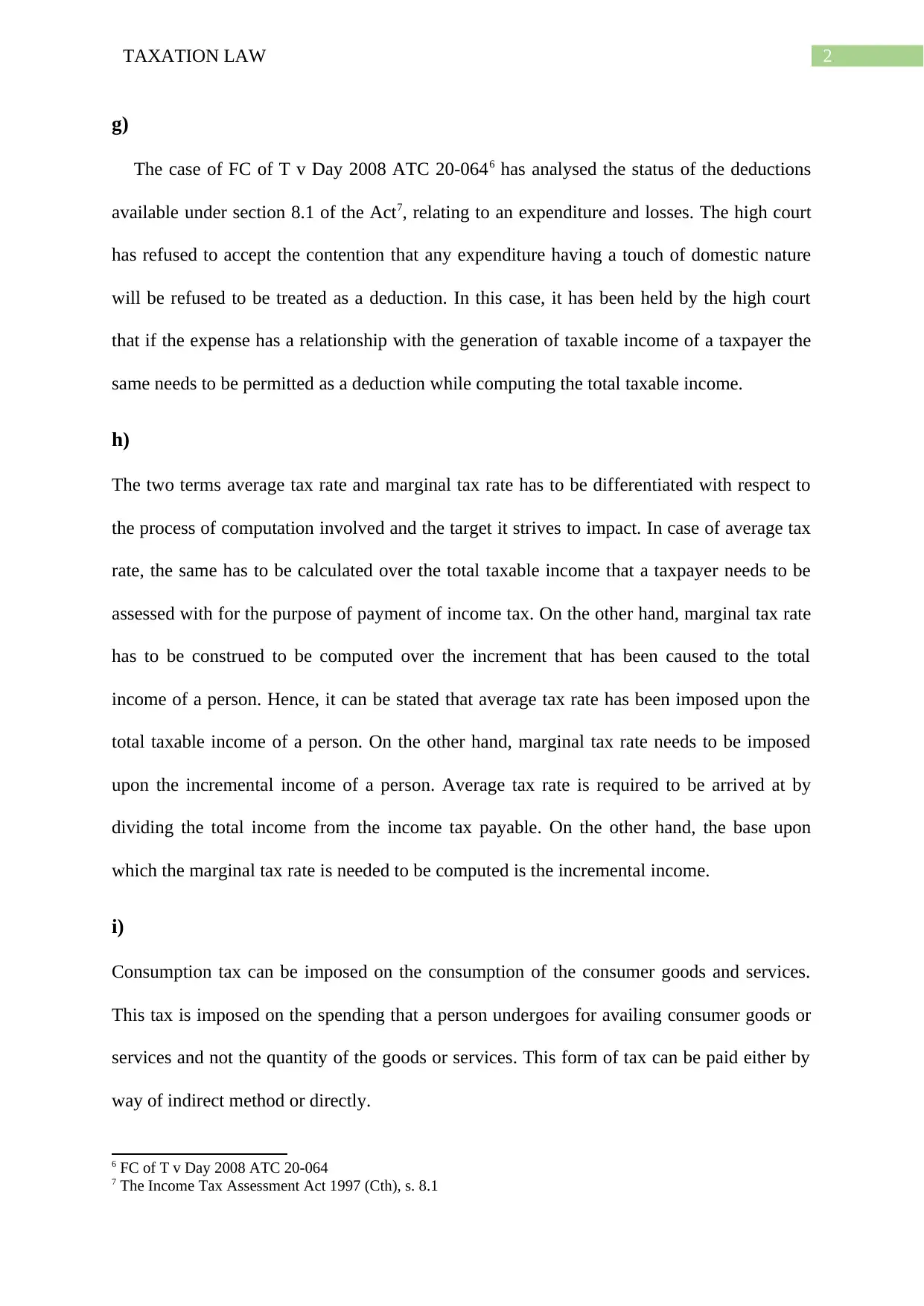
2TAXATION LAW
g)
The case of FC of T v Day 2008 ATC 20-0646 has analysed the status of the deductions
available under section 8.1 of the Act7, relating to an expenditure and losses. The high court
has refused to accept the contention that any expenditure having a touch of domestic nature
will be refused to be treated as a deduction. In this case, it has been held by the high court
that if the expense has a relationship with the generation of taxable income of a taxpayer the
same needs to be permitted as a deduction while computing the total taxable income.
h)
The two terms average tax rate and marginal tax rate has to be differentiated with respect to
the process of computation involved and the target it strives to impact. In case of average tax
rate, the same has to be calculated over the total taxable income that a taxpayer needs to be
assessed with for the purpose of payment of income tax. On the other hand, marginal tax rate
has to be construed to be computed over the increment that has been caused to the total
income of a person. Hence, it can be stated that average tax rate has been imposed upon the
total taxable income of a person. On the other hand, marginal tax rate needs to be imposed
upon the incremental income of a person. Average tax rate is required to be arrived at by
dividing the total income from the income tax payable. On the other hand, the base upon
which the marginal tax rate is needed to be computed is the incremental income.
i)
Consumption tax can be imposed on the consumption of the consumer goods and services.
This tax is imposed on the spending that a person undergoes for availing consumer goods or
services and not the quantity of the goods or services. This form of tax can be paid either by
way of indirect method or directly.
6 FC of T v Day 2008 ATC 20-064
7 The Income Tax Assessment Act 1997 (Cth), s. 8.1
g)
The case of FC of T v Day 2008 ATC 20-0646 has analysed the status of the deductions
available under section 8.1 of the Act7, relating to an expenditure and losses. The high court
has refused to accept the contention that any expenditure having a touch of domestic nature
will be refused to be treated as a deduction. In this case, it has been held by the high court
that if the expense has a relationship with the generation of taxable income of a taxpayer the
same needs to be permitted as a deduction while computing the total taxable income.
h)
The two terms average tax rate and marginal tax rate has to be differentiated with respect to
the process of computation involved and the target it strives to impact. In case of average tax
rate, the same has to be calculated over the total taxable income that a taxpayer needs to be
assessed with for the purpose of payment of income tax. On the other hand, marginal tax rate
has to be construed to be computed over the increment that has been caused to the total
income of a person. Hence, it can be stated that average tax rate has been imposed upon the
total taxable income of a person. On the other hand, marginal tax rate needs to be imposed
upon the incremental income of a person. Average tax rate is required to be arrived at by
dividing the total income from the income tax payable. On the other hand, the base upon
which the marginal tax rate is needed to be computed is the incremental income.
i)
Consumption tax can be imposed on the consumption of the consumer goods and services.
This tax is imposed on the spending that a person undergoes for availing consumer goods or
services and not the quantity of the goods or services. This form of tax can be paid either by
way of indirect method or directly.
6 FC of T v Day 2008 ATC 20-064
7 The Income Tax Assessment Act 1997 (Cth), s. 8.1
⊘ This is a preview!⊘
Do you want full access?
Subscribe today to unlock all pages.

Trusted by 1+ million students worldwide
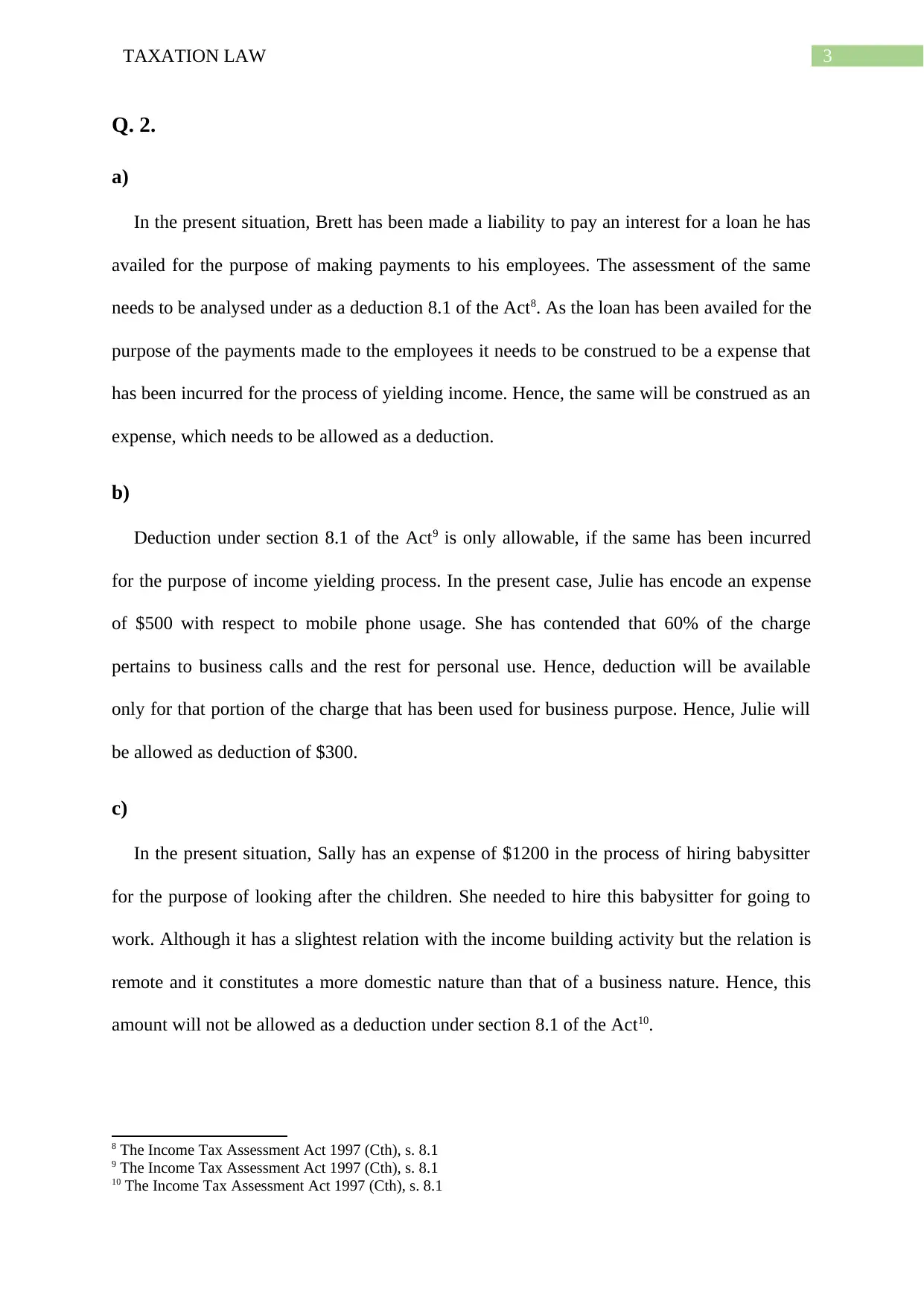
3TAXATION LAW
Q. 2.
a)
In the present situation, Brett has been made a liability to pay an interest for a loan he has
availed for the purpose of making payments to his employees. The assessment of the same
needs to be analysed under as a deduction 8.1 of the Act8. As the loan has been availed for the
purpose of the payments made to the employees it needs to be construed to be a expense that
has been incurred for the process of yielding income. Hence, the same will be construed as an
expense, which needs to be allowed as a deduction.
b)
Deduction under section 8.1 of the Act9 is only allowable, if the same has been incurred
for the purpose of income yielding process. In the present case, Julie has encode an expense
of $500 with respect to mobile phone usage. She has contended that 60% of the charge
pertains to business calls and the rest for personal use. Hence, deduction will be available
only for that portion of the charge that has been used for business purpose. Hence, Julie will
be allowed as deduction of $300.
c)
In the present situation, Sally has an expense of $1200 in the process of hiring babysitter
for the purpose of looking after the children. She needed to hire this babysitter for going to
work. Although it has a slightest relation with the income building activity but the relation is
remote and it constitutes a more domestic nature than that of a business nature. Hence, this
amount will not be allowed as a deduction under section 8.1 of the Act10.
8 The Income Tax Assessment Act 1997 (Cth), s. 8.1
9 The Income Tax Assessment Act 1997 (Cth), s. 8.1
10 The Income Tax Assessment Act 1997 (Cth), s. 8.1
Q. 2.
a)
In the present situation, Brett has been made a liability to pay an interest for a loan he has
availed for the purpose of making payments to his employees. The assessment of the same
needs to be analysed under as a deduction 8.1 of the Act8. As the loan has been availed for the
purpose of the payments made to the employees it needs to be construed to be a expense that
has been incurred for the process of yielding income. Hence, the same will be construed as an
expense, which needs to be allowed as a deduction.
b)
Deduction under section 8.1 of the Act9 is only allowable, if the same has been incurred
for the purpose of income yielding process. In the present case, Julie has encode an expense
of $500 with respect to mobile phone usage. She has contended that 60% of the charge
pertains to business calls and the rest for personal use. Hence, deduction will be available
only for that portion of the charge that has been used for business purpose. Hence, Julie will
be allowed as deduction of $300.
c)
In the present situation, Sally has an expense of $1200 in the process of hiring babysitter
for the purpose of looking after the children. She needed to hire this babysitter for going to
work. Although it has a slightest relation with the income building activity but the relation is
remote and it constitutes a more domestic nature than that of a business nature. Hence, this
amount will not be allowed as a deduction under section 8.1 of the Act10.
8 The Income Tax Assessment Act 1997 (Cth), s. 8.1
9 The Income Tax Assessment Act 1997 (Cth), s. 8.1
10 The Income Tax Assessment Act 1997 (Cth), s. 8.1
Paraphrase This Document
Need a fresh take? Get an instant paraphrase of this document with our AI Paraphraser
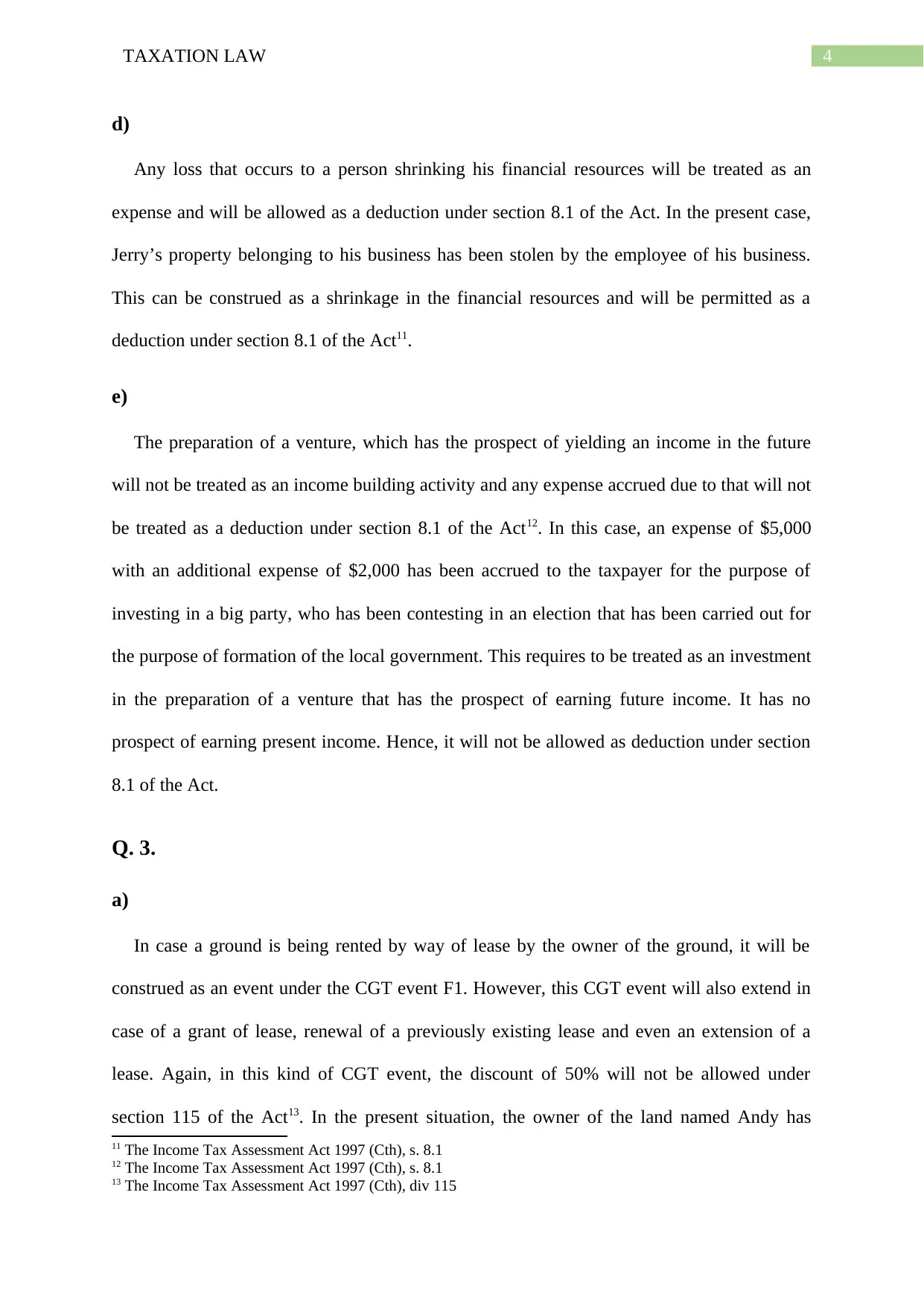
4TAXATION LAW
d)
Any loss that occurs to a person shrinking his financial resources will be treated as an
expense and will be allowed as a deduction under section 8.1 of the Act. In the present case,
Jerry’s property belonging to his business has been stolen by the employee of his business.
This can be construed as a shrinkage in the financial resources and will be permitted as a
deduction under section 8.1 of the Act11.
e)
The preparation of a venture, which has the prospect of yielding an income in the future
will not be treated as an income building activity and any expense accrued due to that will not
be treated as a deduction under section 8.1 of the Act12. In this case, an expense of $5,000
with an additional expense of $2,000 has been accrued to the taxpayer for the purpose of
investing in a big party, who has been contesting in an election that has been carried out for
the purpose of formation of the local government. This requires to be treated as an investment
in the preparation of a venture that has the prospect of earning future income. It has no
prospect of earning present income. Hence, it will not be allowed as deduction under section
8.1 of the Act.
Q. 3.
a)
In case a ground is being rented by way of lease by the owner of the ground, it will be
construed as an event under the CGT event F1. However, this CGT event will also extend in
case of a grant of lease, renewal of a previously existing lease and even an extension of a
lease. Again, in this kind of CGT event, the discount of 50% will not be allowed under
section 115 of the Act13. In the present situation, the owner of the land named Andy has
11 The Income Tax Assessment Act 1997 (Cth), s. 8.1
12 The Income Tax Assessment Act 1997 (Cth), s. 8.1
13 The Income Tax Assessment Act 1997 (Cth), div 115
d)
Any loss that occurs to a person shrinking his financial resources will be treated as an
expense and will be allowed as a deduction under section 8.1 of the Act. In the present case,
Jerry’s property belonging to his business has been stolen by the employee of his business.
This can be construed as a shrinkage in the financial resources and will be permitted as a
deduction under section 8.1 of the Act11.
e)
The preparation of a venture, which has the prospect of yielding an income in the future
will not be treated as an income building activity and any expense accrued due to that will not
be treated as a deduction under section 8.1 of the Act12. In this case, an expense of $5,000
with an additional expense of $2,000 has been accrued to the taxpayer for the purpose of
investing in a big party, who has been contesting in an election that has been carried out for
the purpose of formation of the local government. This requires to be treated as an investment
in the preparation of a venture that has the prospect of earning future income. It has no
prospect of earning present income. Hence, it will not be allowed as deduction under section
8.1 of the Act.
Q. 3.
a)
In case a ground is being rented by way of lease by the owner of the ground, it will be
construed as an event under the CGT event F1. However, this CGT event will also extend in
case of a grant of lease, renewal of a previously existing lease and even an extension of a
lease. Again, in this kind of CGT event, the discount of 50% will not be allowed under
section 115 of the Act13. In the present situation, the owner of the land named Andy has
11 The Income Tax Assessment Act 1997 (Cth), s. 8.1
12 The Income Tax Assessment Act 1997 (Cth), s. 8.1
13 The Income Tax Assessment Act 1997 (Cth), div 115
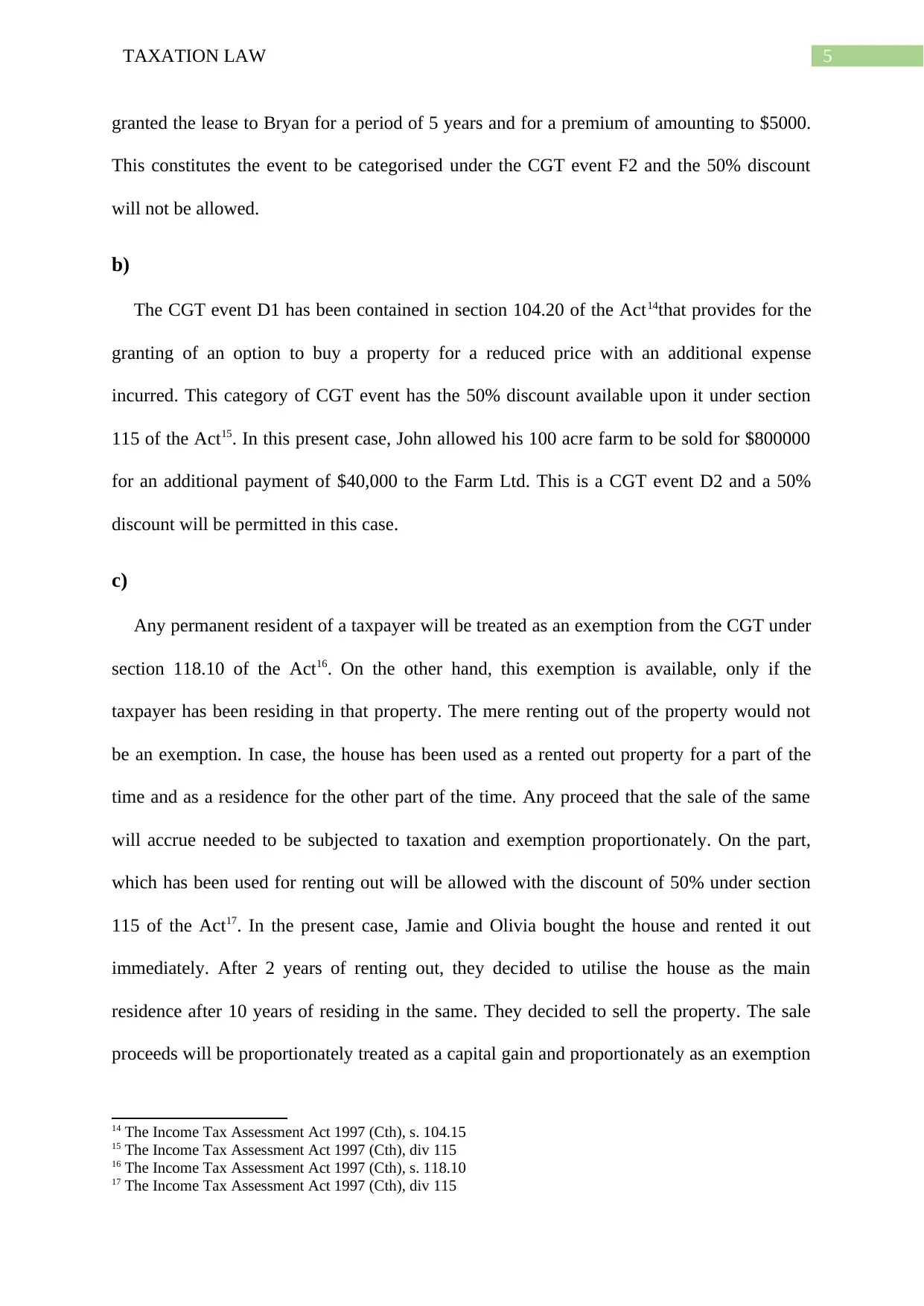
5TAXATION LAW
granted the lease to Bryan for a period of 5 years and for a premium of amounting to $5000.
This constitutes the event to be categorised under the CGT event F2 and the 50% discount
will not be allowed.
b)
The CGT event D1 has been contained in section 104.20 of the Act14that provides for the
granting of an option to buy a property for a reduced price with an additional expense
incurred. This category of CGT event has the 50% discount available upon it under section
115 of the Act15. In this present case, John allowed his 100 acre farm to be sold for $800000
for an additional payment of $40,000 to the Farm Ltd. This is a CGT event D2 and a 50%
discount will be permitted in this case.
c)
Any permanent resident of a taxpayer will be treated as an exemption from the CGT under
section 118.10 of the Act16. On the other hand, this exemption is available, only if the
taxpayer has been residing in that property. The mere renting out of the property would not
be an exemption. In case, the house has been used as a rented out property for a part of the
time and as a residence for the other part of the time. Any proceed that the sale of the same
will accrue needed to be subjected to taxation and exemption proportionately. On the part,
which has been used for renting out will be allowed with the discount of 50% under section
115 of the Act17. In the present case, Jamie and Olivia bought the house and rented it out
immediately. After 2 years of renting out, they decided to utilise the house as the main
residence after 10 years of residing in the same. They decided to sell the property. The sale
proceeds will be proportionately treated as a capital gain and proportionately as an exemption
14 The Income Tax Assessment Act 1997 (Cth), s. 104.15
15 The Income Tax Assessment Act 1997 (Cth), div 115
16 The Income Tax Assessment Act 1997 (Cth), s. 118.10
17 The Income Tax Assessment Act 1997 (Cth), div 115
granted the lease to Bryan for a period of 5 years and for a premium of amounting to $5000.
This constitutes the event to be categorised under the CGT event F2 and the 50% discount
will not be allowed.
b)
The CGT event D1 has been contained in section 104.20 of the Act14that provides for the
granting of an option to buy a property for a reduced price with an additional expense
incurred. This category of CGT event has the 50% discount available upon it under section
115 of the Act15. In this present case, John allowed his 100 acre farm to be sold for $800000
for an additional payment of $40,000 to the Farm Ltd. This is a CGT event D2 and a 50%
discount will be permitted in this case.
c)
Any permanent resident of a taxpayer will be treated as an exemption from the CGT under
section 118.10 of the Act16. On the other hand, this exemption is available, only if the
taxpayer has been residing in that property. The mere renting out of the property would not
be an exemption. In case, the house has been used as a rented out property for a part of the
time and as a residence for the other part of the time. Any proceed that the sale of the same
will accrue needed to be subjected to taxation and exemption proportionately. On the part,
which has been used for renting out will be allowed with the discount of 50% under section
115 of the Act17. In the present case, Jamie and Olivia bought the house and rented it out
immediately. After 2 years of renting out, they decided to utilise the house as the main
residence after 10 years of residing in the same. They decided to sell the property. The sale
proceeds will be proportionately treated as a capital gain and proportionately as an exemption
14 The Income Tax Assessment Act 1997 (Cth), s. 104.15
15 The Income Tax Assessment Act 1997 (Cth), div 115
16 The Income Tax Assessment Act 1997 (Cth), s. 118.10
17 The Income Tax Assessment Act 1997 (Cth), div 115
⊘ This is a preview!⊘
Do you want full access?
Subscribe today to unlock all pages.

Trusted by 1+ million students worldwide
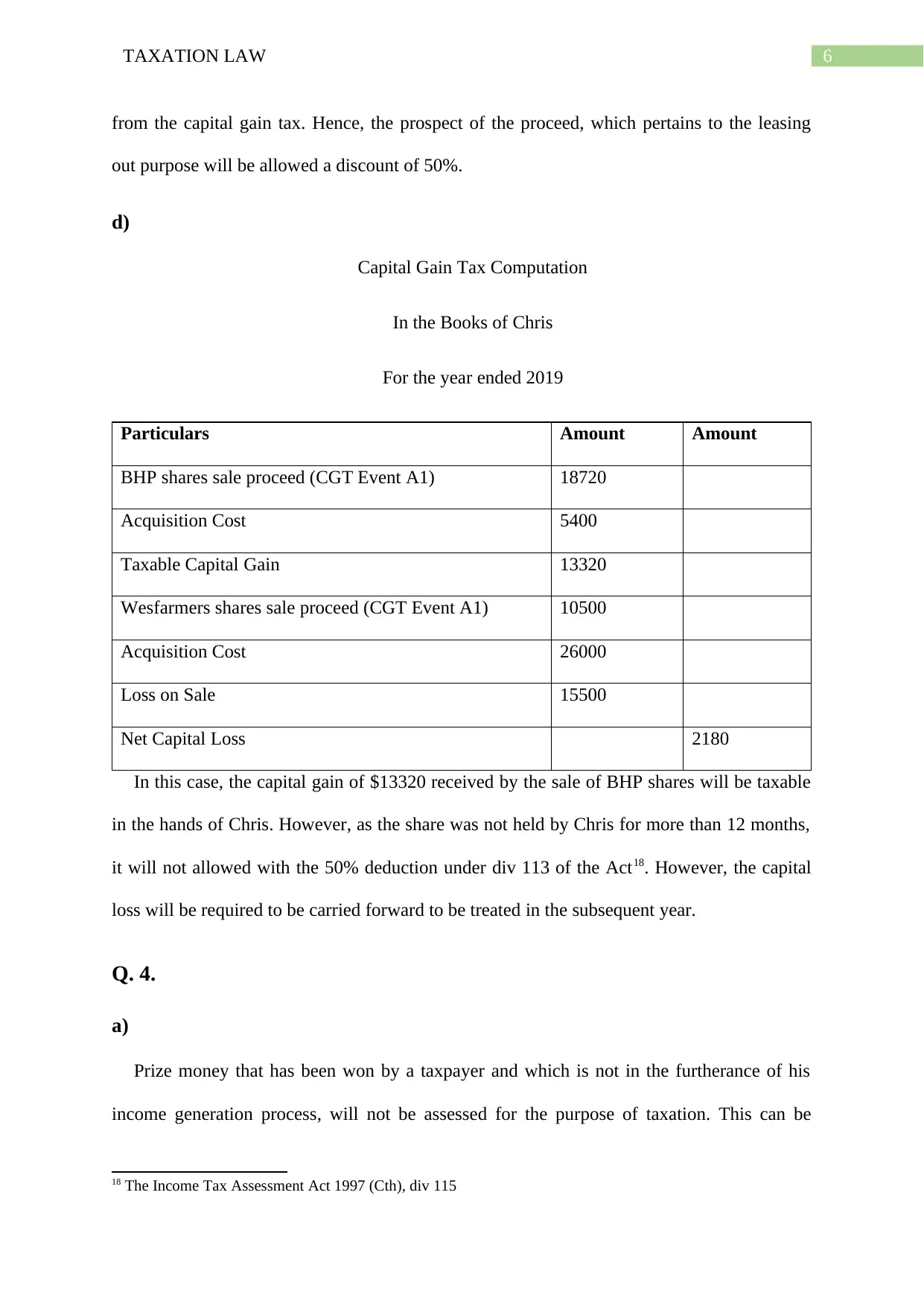
6TAXATION LAW
from the capital gain tax. Hence, the prospect of the proceed, which pertains to the leasing
out purpose will be allowed a discount of 50%.
d)
Capital Gain Tax Computation
In the Books of Chris
For the year ended 2019
Particulars Amount Amount
BHP shares sale proceed (CGT Event A1) 18720
Acquisition Cost 5400
Taxable Capital Gain 13320
Wesfarmers shares sale proceed (CGT Event A1) 10500
Acquisition Cost 26000
Loss on Sale 15500
Net Capital Loss 2180
In this case, the capital gain of $13320 received by the sale of BHP shares will be taxable
in the hands of Chris. However, as the share was not held by Chris for more than 12 months,
it will not allowed with the 50% deduction under div 113 of the Act18. However, the capital
loss will be required to be carried forward to be treated in the subsequent year.
Q. 4.
a)
Prize money that has been won by a taxpayer and which is not in the furtherance of his
income generation process, will not be assessed for the purpose of taxation. This can be
18 The Income Tax Assessment Act 1997 (Cth), div 115
from the capital gain tax. Hence, the prospect of the proceed, which pertains to the leasing
out purpose will be allowed a discount of 50%.
d)
Capital Gain Tax Computation
In the Books of Chris
For the year ended 2019
Particulars Amount Amount
BHP shares sale proceed (CGT Event A1) 18720
Acquisition Cost 5400
Taxable Capital Gain 13320
Wesfarmers shares sale proceed (CGT Event A1) 10500
Acquisition Cost 26000
Loss on Sale 15500
Net Capital Loss 2180
In this case, the capital gain of $13320 received by the sale of BHP shares will be taxable
in the hands of Chris. However, as the share was not held by Chris for more than 12 months,
it will not allowed with the 50% deduction under div 113 of the Act18. However, the capital
loss will be required to be carried forward to be treated in the subsequent year.
Q. 4.
a)
Prize money that has been won by a taxpayer and which is not in the furtherance of his
income generation process, will not be assessed for the purpose of taxation. This can be
18 The Income Tax Assessment Act 1997 (Cth), div 115
Paraphrase This Document
Need a fresh take? Get an instant paraphrase of this document with our AI Paraphraser
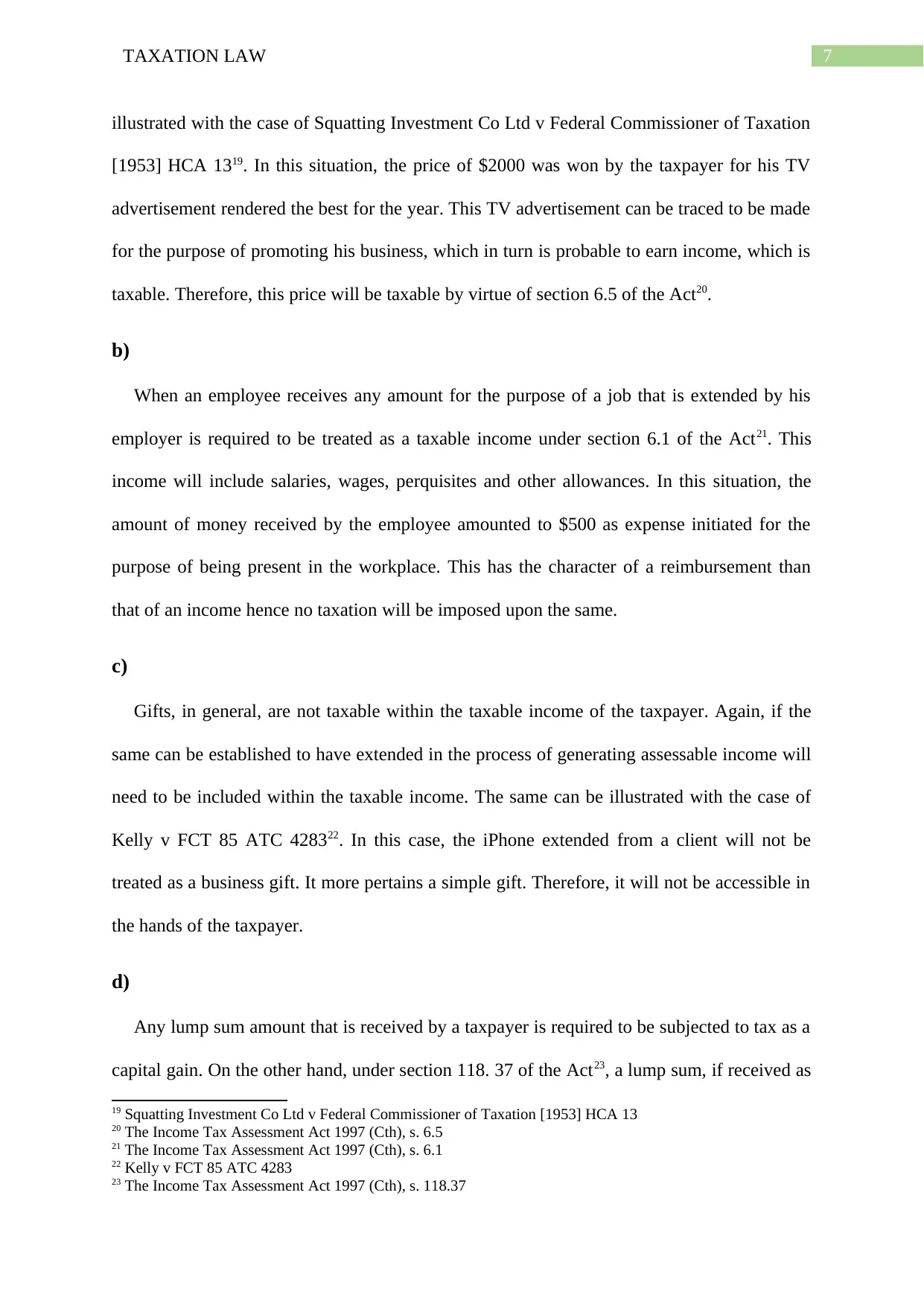
7TAXATION LAW
illustrated with the case of Squatting Investment Co Ltd v Federal Commissioner of Taxation
[1953] HCA 1319. In this situation, the price of $2000 was won by the taxpayer for his TV
advertisement rendered the best for the year. This TV advertisement can be traced to be made
for the purpose of promoting his business, which in turn is probable to earn income, which is
taxable. Therefore, this price will be taxable by virtue of section 6.5 of the Act20.
b)
When an employee receives any amount for the purpose of a job that is extended by his
employer is required to be treated as a taxable income under section 6.1 of the Act21. This
income will include salaries, wages, perquisites and other allowances. In this situation, the
amount of money received by the employee amounted to $500 as expense initiated for the
purpose of being present in the workplace. This has the character of a reimbursement than
that of an income hence no taxation will be imposed upon the same.
c)
Gifts, in general, are not taxable within the taxable income of the taxpayer. Again, if the
same can be established to have extended in the process of generating assessable income will
need to be included within the taxable income. The same can be illustrated with the case of
Kelly v FCT 85 ATC 428322. In this case, the iPhone extended from a client will not be
treated as a business gift. It more pertains a simple gift. Therefore, it will not be accessible in
the hands of the taxpayer.
d)
Any lump sum amount that is received by a taxpayer is required to be subjected to tax as a
capital gain. On the other hand, under section 118. 37 of the Act23, a lump sum, if received as
19 Squatting Investment Co Ltd v Federal Commissioner of Taxation [1953] HCA 13
20 The Income Tax Assessment Act 1997 (Cth), s. 6.5
21 The Income Tax Assessment Act 1997 (Cth), s. 6.1
22 Kelly v FCT 85 ATC 4283
23 The Income Tax Assessment Act 1997 (Cth), s. 118.37
illustrated with the case of Squatting Investment Co Ltd v Federal Commissioner of Taxation
[1953] HCA 1319. In this situation, the price of $2000 was won by the taxpayer for his TV
advertisement rendered the best for the year. This TV advertisement can be traced to be made
for the purpose of promoting his business, which in turn is probable to earn income, which is
taxable. Therefore, this price will be taxable by virtue of section 6.5 of the Act20.
b)
When an employee receives any amount for the purpose of a job that is extended by his
employer is required to be treated as a taxable income under section 6.1 of the Act21. This
income will include salaries, wages, perquisites and other allowances. In this situation, the
amount of money received by the employee amounted to $500 as expense initiated for the
purpose of being present in the workplace. This has the character of a reimbursement than
that of an income hence no taxation will be imposed upon the same.
c)
Gifts, in general, are not taxable within the taxable income of the taxpayer. Again, if the
same can be established to have extended in the process of generating assessable income will
need to be included within the taxable income. The same can be illustrated with the case of
Kelly v FCT 85 ATC 428322. In this case, the iPhone extended from a client will not be
treated as a business gift. It more pertains a simple gift. Therefore, it will not be accessible in
the hands of the taxpayer.
d)
Any lump sum amount that is received by a taxpayer is required to be subjected to tax as a
capital gain. On the other hand, under section 118. 37 of the Act23, a lump sum, if received as
19 Squatting Investment Co Ltd v Federal Commissioner of Taxation [1953] HCA 13
20 The Income Tax Assessment Act 1997 (Cth), s. 6.5
21 The Income Tax Assessment Act 1997 (Cth), s. 6.1
22 Kelly v FCT 85 ATC 4283
23 The Income Tax Assessment Act 1997 (Cth), s. 118.37
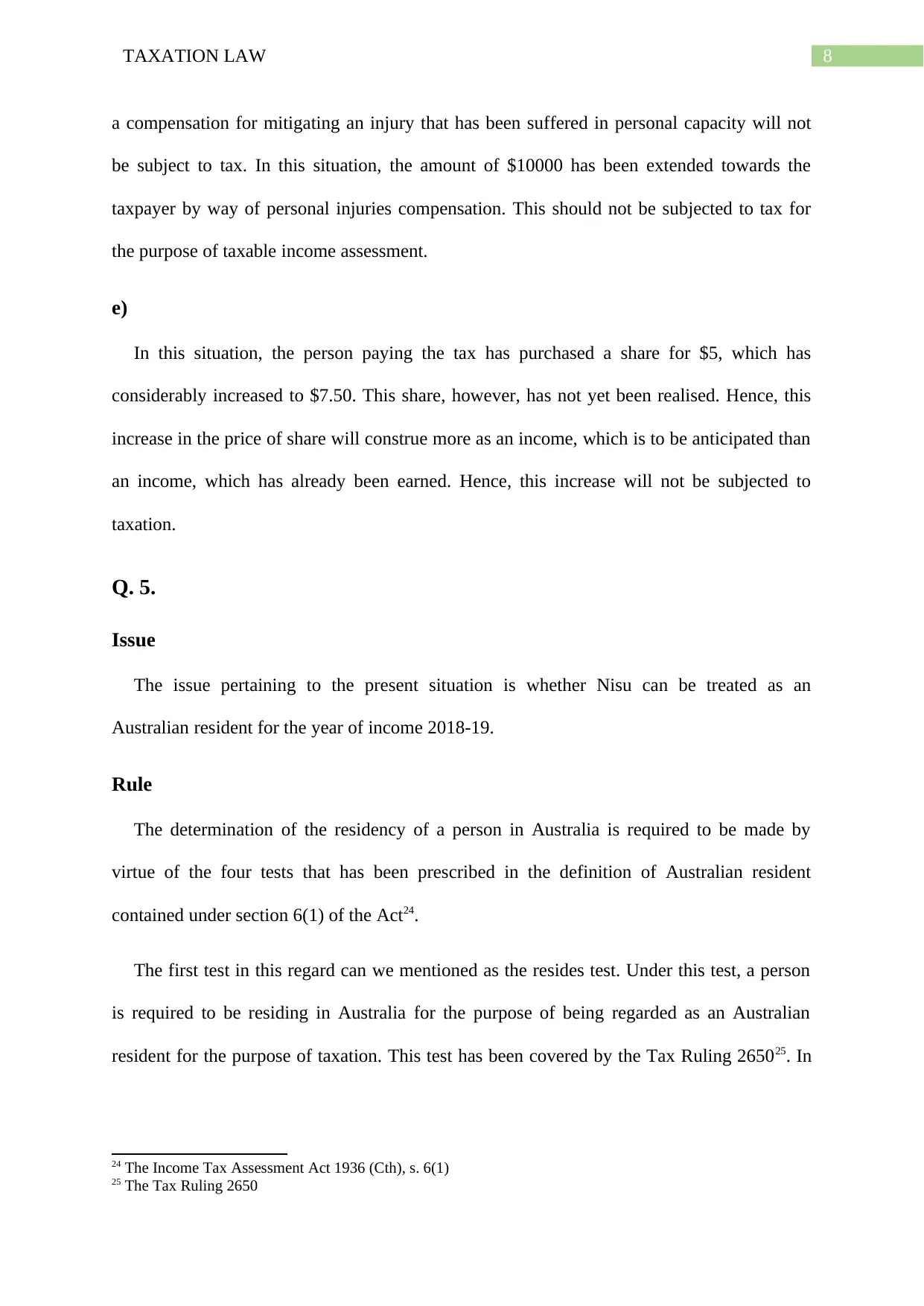
8TAXATION LAW
a compensation for mitigating an injury that has been suffered in personal capacity will not
be subject to tax. In this situation, the amount of $10000 has been extended towards the
taxpayer by way of personal injuries compensation. This should not be subjected to tax for
the purpose of taxable income assessment.
e)
In this situation, the person paying the tax has purchased a share for $5, which has
considerably increased to $7.50. This share, however, has not yet been realised. Hence, this
increase in the price of share will construe more as an income, which is to be anticipated than
an income, which has already been earned. Hence, this increase will not be subjected to
taxation.
Q. 5.
Issue
The issue pertaining to the present situation is whether Nisu can be treated as an
Australian resident for the year of income 2018-19.
Rule
The determination of the residency of a person in Australia is required to be made by
virtue of the four tests that has been prescribed in the definition of Australian resident
contained under section 6(1) of the Act24.
The first test in this regard can we mentioned as the resides test. Under this test, a person
is required to be residing in Australia for the purpose of being regarded as an Australian
resident for the purpose of taxation. This test has been covered by the Tax Ruling 265025. In
24 The Income Tax Assessment Act 1936 (Cth), s. 6(1)
25 The Tax Ruling 2650
a compensation for mitigating an injury that has been suffered in personal capacity will not
be subject to tax. In this situation, the amount of $10000 has been extended towards the
taxpayer by way of personal injuries compensation. This should not be subjected to tax for
the purpose of taxable income assessment.
e)
In this situation, the person paying the tax has purchased a share for $5, which has
considerably increased to $7.50. This share, however, has not yet been realised. Hence, this
increase in the price of share will construe more as an income, which is to be anticipated than
an income, which has already been earned. Hence, this increase will not be subjected to
taxation.
Q. 5.
Issue
The issue pertaining to the present situation is whether Nisu can be treated as an
Australian resident for the year of income 2018-19.
Rule
The determination of the residency of a person in Australia is required to be made by
virtue of the four tests that has been prescribed in the definition of Australian resident
contained under section 6(1) of the Act24.
The first test in this regard can we mentioned as the resides test. Under this test, a person
is required to be residing in Australia for the purpose of being regarded as an Australian
resident for the purpose of taxation. This test has been covered by the Tax Ruling 265025. In
24 The Income Tax Assessment Act 1936 (Cth), s. 6(1)
25 The Tax Ruling 2650
⊘ This is a preview!⊘
Do you want full access?
Subscribe today to unlock all pages.

Trusted by 1+ million students worldwide
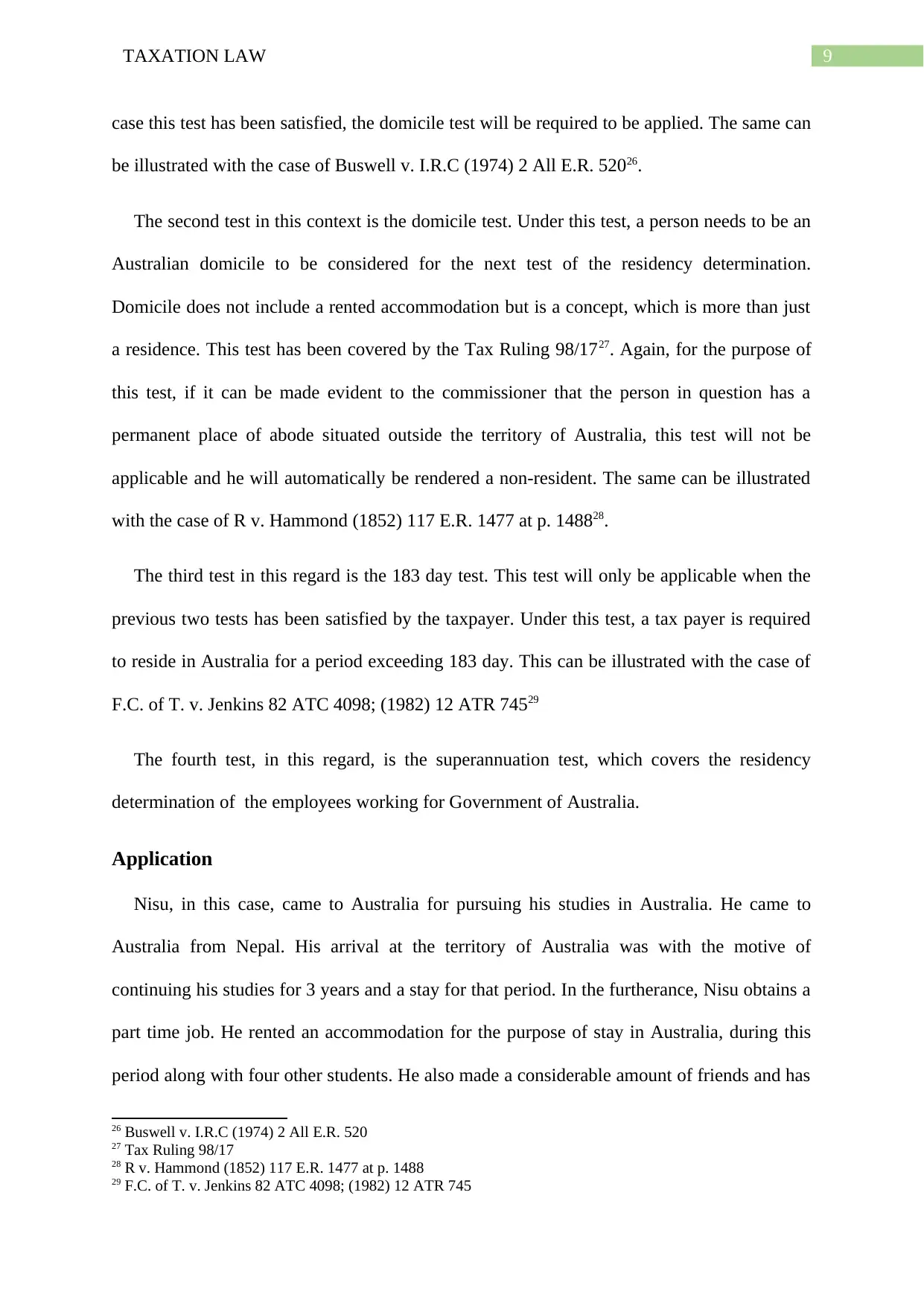
9TAXATION LAW
case this test has been satisfied, the domicile test will be required to be applied. The same can
be illustrated with the case of Buswell v. I.R.C (1974) 2 All E.R. 52026.
The second test in this context is the domicile test. Under this test, a person needs to be an
Australian domicile to be considered for the next test of the residency determination.
Domicile does not include a rented accommodation but is a concept, which is more than just
a residence. This test has been covered by the Tax Ruling 98/1727. Again, for the purpose of
this test, if it can be made evident to the commissioner that the person in question has a
permanent place of abode situated outside the territory of Australia, this test will not be
applicable and he will automatically be rendered a non-resident. The same can be illustrated
with the case of R v. Hammond (1852) 117 E.R. 1477 at p. 148828.
The third test in this regard is the 183 day test. This test will only be applicable when the
previous two tests has been satisfied by the taxpayer. Under this test, a tax payer is required
to reside in Australia for a period exceeding 183 day. This can be illustrated with the case of
F.C. of T. v. Jenkins 82 ATC 4098; (1982) 12 ATR 74529
The fourth test, in this regard, is the superannuation test, which covers the residency
determination of the employees working for Government of Australia.
Application
Nisu, in this case, came to Australia for pursuing his studies in Australia. He came to
Australia from Nepal. His arrival at the territory of Australia was with the motive of
continuing his studies for 3 years and a stay for that period. In the furtherance, Nisu obtains a
part time job. He rented an accommodation for the purpose of stay in Australia, during this
period along with four other students. He also made a considerable amount of friends and has
26 Buswell v. I.R.C (1974) 2 All E.R. 520
27 Tax Ruling 98/17
28 R v. Hammond (1852) 117 E.R. 1477 at p. 1488
29 F.C. of T. v. Jenkins 82 ATC 4098; (1982) 12 ATR 745
case this test has been satisfied, the domicile test will be required to be applied. The same can
be illustrated with the case of Buswell v. I.R.C (1974) 2 All E.R. 52026.
The second test in this context is the domicile test. Under this test, a person needs to be an
Australian domicile to be considered for the next test of the residency determination.
Domicile does not include a rented accommodation but is a concept, which is more than just
a residence. This test has been covered by the Tax Ruling 98/1727. Again, for the purpose of
this test, if it can be made evident to the commissioner that the person in question has a
permanent place of abode situated outside the territory of Australia, this test will not be
applicable and he will automatically be rendered a non-resident. The same can be illustrated
with the case of R v. Hammond (1852) 117 E.R. 1477 at p. 148828.
The third test in this regard is the 183 day test. This test will only be applicable when the
previous two tests has been satisfied by the taxpayer. Under this test, a tax payer is required
to reside in Australia for a period exceeding 183 day. This can be illustrated with the case of
F.C. of T. v. Jenkins 82 ATC 4098; (1982) 12 ATR 74529
The fourth test, in this regard, is the superannuation test, which covers the residency
determination of the employees working for Government of Australia.
Application
Nisu, in this case, came to Australia for pursuing his studies in Australia. He came to
Australia from Nepal. His arrival at the territory of Australia was with the motive of
continuing his studies for 3 years and a stay for that period. In the furtherance, Nisu obtains a
part time job. He rented an accommodation for the purpose of stay in Australia, during this
period along with four other students. He also made a considerable amount of friends and has
26 Buswell v. I.R.C (1974) 2 All E.R. 520
27 Tax Ruling 98/17
28 R v. Hammond (1852) 117 E.R. 1477 at p. 1488
29 F.C. of T. v. Jenkins 82 ATC 4098; (1982) 12 ATR 745
Paraphrase This Document
Need a fresh take? Get an instant paraphrase of this document with our AI Paraphraser
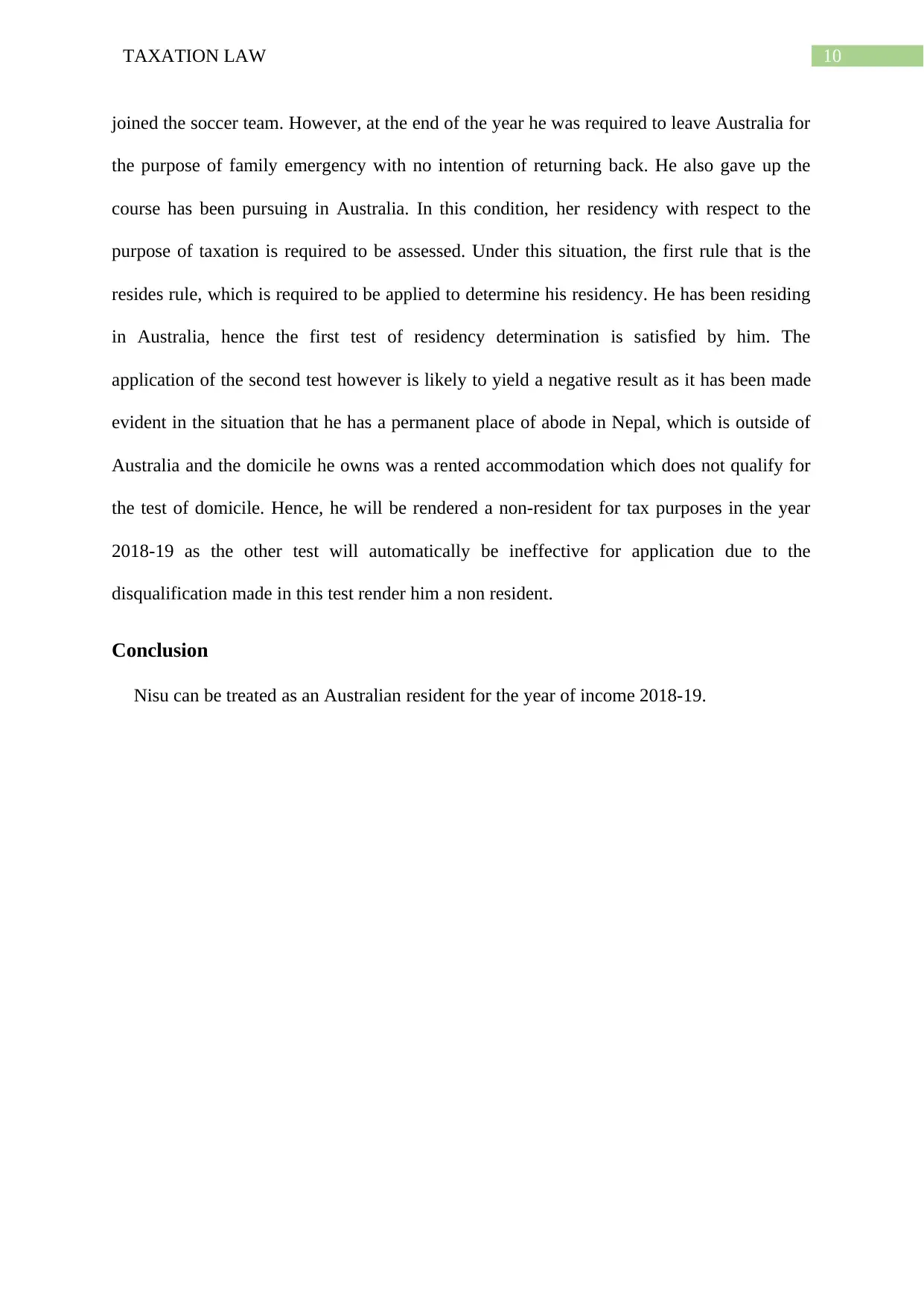
10TAXATION LAW
joined the soccer team. However, at the end of the year he was required to leave Australia for
the purpose of family emergency with no intention of returning back. He also gave up the
course has been pursuing in Australia. In this condition, her residency with respect to the
purpose of taxation is required to be assessed. Under this situation, the first rule that is the
resides rule, which is required to be applied to determine his residency. He has been residing
in Australia, hence the first test of residency determination is satisfied by him. The
application of the second test however is likely to yield a negative result as it has been made
evident in the situation that he has a permanent place of abode in Nepal, which is outside of
Australia and the domicile he owns was a rented accommodation which does not qualify for
the test of domicile. Hence, he will be rendered a non-resident for tax purposes in the year
2018-19 as the other test will automatically be ineffective for application due to the
disqualification made in this test render him a non resident.
Conclusion
Nisu can be treated as an Australian resident for the year of income 2018-19.
joined the soccer team. However, at the end of the year he was required to leave Australia for
the purpose of family emergency with no intention of returning back. He also gave up the
course has been pursuing in Australia. In this condition, her residency with respect to the
purpose of taxation is required to be assessed. Under this situation, the first rule that is the
resides rule, which is required to be applied to determine his residency. He has been residing
in Australia, hence the first test of residency determination is satisfied by him. The
application of the second test however is likely to yield a negative result as it has been made
evident in the situation that he has a permanent place of abode in Nepal, which is outside of
Australia and the domicile he owns was a rented accommodation which does not qualify for
the test of domicile. Hence, he will be rendered a non-resident for tax purposes in the year
2018-19 as the other test will automatically be ineffective for application due to the
disqualification made in this test render him a non resident.
Conclusion
Nisu can be treated as an Australian resident for the year of income 2018-19.
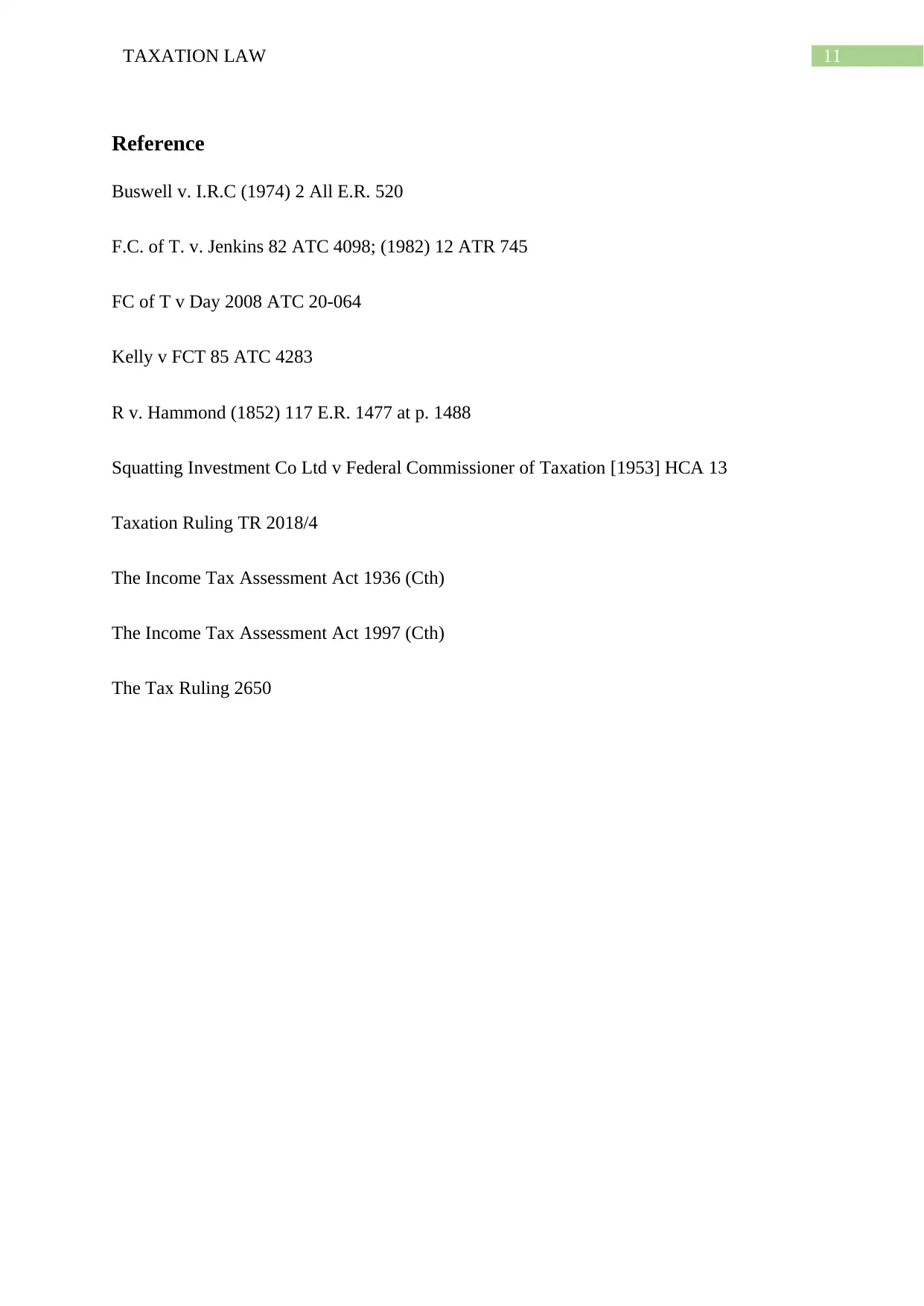
11TAXATION LAW
Reference
Buswell v. I.R.C (1974) 2 All E.R. 520
F.C. of T. v. Jenkins 82 ATC 4098; (1982) 12 ATR 745
FC of T v Day 2008 ATC 20-064
Kelly v FCT 85 ATC 4283
R v. Hammond (1852) 117 E.R. 1477 at p. 1488
Squatting Investment Co Ltd v Federal Commissioner of Taxation [1953] HCA 13
Taxation Ruling TR 2018/4
The Income Tax Assessment Act 1936 (Cth)
The Income Tax Assessment Act 1997 (Cth)
The Tax Ruling 2650
Reference
Buswell v. I.R.C (1974) 2 All E.R. 520
F.C. of T. v. Jenkins 82 ATC 4098; (1982) 12 ATR 745
FC of T v Day 2008 ATC 20-064
Kelly v FCT 85 ATC 4283
R v. Hammond (1852) 117 E.R. 1477 at p. 1488
Squatting Investment Co Ltd v Federal Commissioner of Taxation [1953] HCA 13
Taxation Ruling TR 2018/4
The Income Tax Assessment Act 1936 (Cth)
The Income Tax Assessment Act 1997 (Cth)
The Tax Ruling 2650
⊘ This is a preview!⊘
Do you want full access?
Subscribe today to unlock all pages.

Trusted by 1+ million students worldwide
1 out of 12
Related Documents
Your All-in-One AI-Powered Toolkit for Academic Success.
+13062052269
info@desklib.com
Available 24*7 on WhatsApp / Email
![[object Object]](/_next/static/media/star-bottom.7253800d.svg)
Unlock your academic potential
Copyright © 2020–2025 A2Z Services. All Rights Reserved. Developed and managed by ZUCOL.





